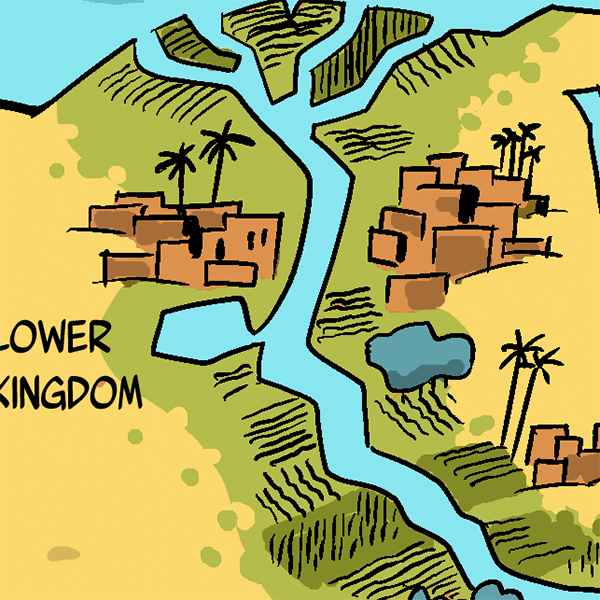Is it a coincidence that the Hebrew word for evil is ra and that Ra just so happens to be the most powerful of the Egyptian gods (the very one that pharaohs were often said to be incarnations of)? Many academic scholars argue that it is not! Indeed, the fact that Israelites used that word for what they saw as evil lends significant linguistic evidence to the claim that our ancestors were, in fact, slaves in Egypt.
Another interesting linguistic tell is the presence of Egyptian-sounding Biblical names like Pinchas, Chofni, and Chur. In fact, even the name “Moshe” is at least partially an Egyptian play-on-words. The Torah explains that Pharaoh’s daughter Batya (itself literally translated as “daughter of God,” which not only hearkens to her midrashic conversion to Judaism but also perhaps to Egyptian ideas about pharoah’s supposed divinity) named the Jewish baby she found Moshe because ki min ha-mayim mishitihu – from the water, she drew him. But the word moshe also means “child” in ancient Egyptian (the anglicized name “Ramses” comes from the same root, meaning “child of Ra”). What might and Egyptian have named a child floating in the river whose true name she did not know? Perhaps just “child!”
But support for our ancestors’ exodus from Egypt is not only linguistic. The Orthodox biblical scholar, university professor, and author Rabbi Dr. Joshua Berman has outlined several fascinating reasons to believe that the Jewish people were in Egypt. Here are some of them:

“Many details of the exodus story do strikingly appear to reflect the realities of late-second-millennium Egypt, the period when the exodus would most likely have taken place—and they are the sorts of details that a scribe living centuries later and inventing the story afresh would have been unlikely to know:
- There is rich evidence that West-Semitic populations lived in the eastern Nile delta—what the Bible calls Goshen—for most of the second millennium. Some were slaves, some were raised in Pharaoh’s court, and some, like Moses, bore Egyptian names.
- We know today that the great pharaoh Ramesses II, who reigned from 1279 to 1213 BCE, built a huge administrative center out of mudbrick in an area where large Semitic populations had lived for centuries. It was called Pi-Ramesses. Exodus (1:11) specifies that the Hebrew slaves built the cities of Pithom and Ramesses, a possible reference to Pi-Ramesses. The site was abandoned by the pharaohs two centuries later.
- In the exodus account, pharaohs are simply called “Pharaoh,” whereas in later biblical passages, Egyptian monarchs are referred to by their proper name, as in “Pharaoh Necho” (2 Kings 23:29). This, too, echoes usage in Egypt itself, where, from the middle of the second millennium until the tenth century BCE, the title “Pharaoh” was used alone.
- The names of various national entities mentioned in the Song at the Sea (Exodus 15:1-18)—Philistines, Moabites, Edomites, et al.—are all found in Egyptian sources shortly before 1200 BCE; about this, the book of Exodus is again correct for the period.
- The stories of the exodus and the Israelites’ subsequent wanderings in the wilderness reflect sound acquaintance with the geography and natural conditions of the eastern Nile delta, the Sinai peninsula, the Negev, and Transjordan.
- The book of Exodus (13:17) notes that the Israelites chose not to traverse the Sinai peninsula along the northern, coastal route toward modern-day Gaza because that would have entailed military engagement. The discovery of extensive Egyptian fortifications all along that route from the period in question confirms the accuracy of this observation.
- Archaeologists have documented hundreds of new settlements in the land of Israel from the late-13th and 12th centuries BCE, congruent with the biblically attested arrival there of the liberated slaves; strikingly, these settlements feature an absence of the pig bones normally found in such places. Major destruction is found at Bethel, Yokne’am, and Hatzor—cities taken by Israel according to the book of Joshua. At Hatzor, archaeologists found mutilated cultic statues, suggesting that they were repugnant to the invaders.
- The earliest written mention of an entity called “Israel” is found in the victory inscription of the pharaoh Merneptah from 1206 BCE. In it the pharaoh lists the nations defeated by him in the course of a campaign to the southern Levant; among them, “Israel is laid waste and his seed is no more.” “Israel” is written in such a way as to connote a group of people, not an established city or region, the implication being that it was not yet a fully settled entity with contiguous control over an entire region. This jibes with the Bible’s description in Joshua and Judges of a gradual conquest of the land.”
As we go into Shabbat and then the last days of Passover, then, we can do so with the confidence that our people’s freedom from Egyptian slavery is not only historical but ought to inspire our own stories today! Shabbat Shalom and Chag Kasher Ve’Sameach!

